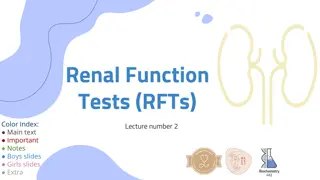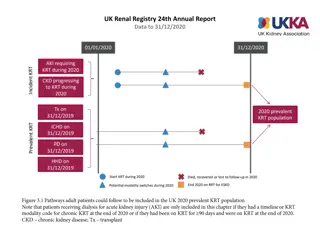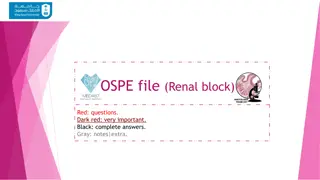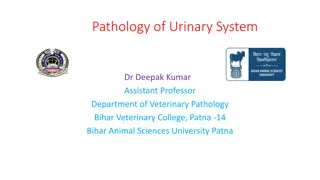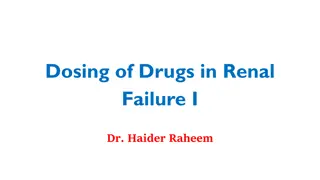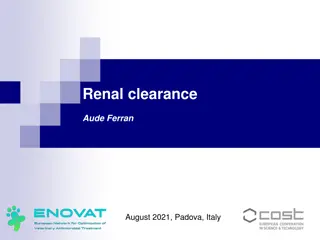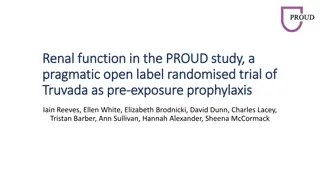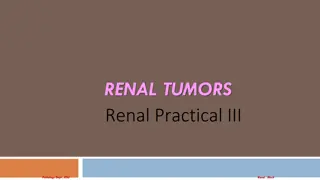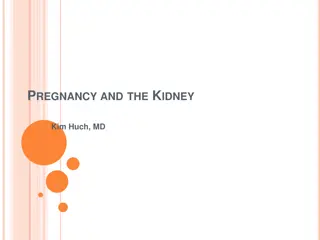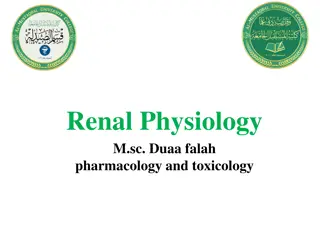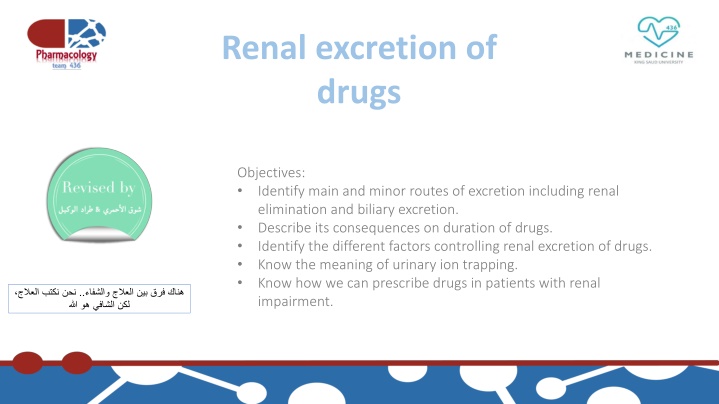
Renal Excretion of Drugs and Its Implications
Explore the main and minor routes of drug excretion, focusing on renal elimination and biliary excretion. Learn about factors influencing renal excretion, urinary ion trapping, and prescribing drugs for patients with renal impairment. Delve into the anatomy and physiology of the kidney, glomerular filtration, and drug excretion processes. Gain insights into the significance of GFR, active tubular secretion, and tubular reabsorption in drug elimination.
Download Presentation

Please find below an Image/Link to download the presentation.
The content on the website is provided AS IS for your information and personal use only. It may not be sold, licensed, or shared on other websites without obtaining consent from the author. If you encounter any issues during the download, it is possible that the publisher has removed the file from their server.
You are allowed to download the files provided on this website for personal or commercial use, subject to the condition that they are used lawfully. All files are the property of their respective owners.
The content on the website is provided AS IS for your information and personal use only. It may not be sold, licensed, or shared on other websites without obtaining consent from the author.
E N D
Presentation Transcript
Renal excretion of drugs Objectives: Identify main and minor routes of excretion including renal elimination and biliary excretion. Describe its consequences on duration of drugs. Identify the different factors controlling renal excretion of drugs. Know the meaning of urinary ion trapping. Know how we can prescribe drugs in patients with renal impairment. ..
Extra slide: outline of the lecture Renal excretion of drugs 1.Brief anatomy & physiology of the kidney. 3.factors affecting renal excretion of drugs: 6.examples of drugs excreted mainly by the kidney. 7.risk factors for NSAIDS- associated acute renal failure. 2.renal excretion of drugs. 4.Urinary pH trapping + examples. 5.Creatinine clearance and drug excretion. 8.orders of drug elimination: Glomerular filtration active tubular secretion tubular reabsorption physiochemical properties Zero order renal blood flow biological factors disease state pH of urine characters of active tubular secretion passive tubular reabsorption of drugs Glomerular filtration of drugs First order Molecular weight active tubular reabsorption of drugs types of transporters GFR Lipid solubility competitive tubular secretion of drugs Volume of distribution Binding characteristics of drugs 2
just for you understanding just for you understanding Structure of the kidney: The structural unit of the kidney is the NEPHRON consists of: Glomerulus. Proximal convoluted tubule. Loop of Henle that is divided to: o Descending loop of Henle. o Ascending loop of Henle. Distal convoluted tubule. Collecting duct. Routes of excretion NEPHRON which Minor Major Renal excretion Pulmonary excretion Biliary excretion Salivary excretion Mammary excretion Kidneys are the most important organ for drug excretion. Skin excretion via sweating 3
just for you understanding 1. Glomerular filtration: Blood is filtered across a semi-permeable membrane into the Bowman s capsule. Driving forces for Glomerular Filtration is hydrostatic pressure of blood flowing in the capillaries. Filtrate contains Water, Glucose, Amino Acids, Sodium Bicarbonates, organic solutes and electrolytes such as Sodium, Potassium and Chloride. Blood cells, platelets and plasma proteins are retained in the blood and NOT filtered. Normal function of the kidney 1. Regulation of electrolytes (aldosterone). 2. Regulation of water balance (anti-diuretic hormone). 3. Excretion of wastes and drugs metabolites such as: Urea. Uric acid. Creatinine. Renal excretion of drugs Very important Urinary excretion of drugs occurs through three processes: Glomerular filtration of drugs: Glomerular filtration of drugs occurs to: o Drugs with low molecular weight. o Water soluble (polar = ionized) drugs such as Aminoglycosides and Tubocurarine. o Plasma free drugs. (not bound to plasma proteins). o Drugs with low volume of distribution. (Higher the volume less the excretion. Because the amount available for excretion will be less.) In other words, If a drug is highly distributed, it won t be present in the blood to be filtered. Suppose a drug has low volume of distribution? It will be present in the blood then after filtration about 90% of the drug is filtered, thus the excretion will be high. Glomerular Filtration Rate (GFR): It s the amount of blood filtered by the glomeruli in a given time. Normal glomerular filtration rate (GFR) = 125 ml/min. GFR is used as an indicator for kidney function. GFR is determined by Creatinine and Inulin which is easily filtered by the kidney and NOT reabsorbed. Creatinine clearance (CrCl) is used as a marker instead of GFR. Glomerular filtration. Active tubular secretion. Tubular reabsorption. 4
Competitive active tubular secretion of drugs: Two structurally similar drugs having similar ionic charge and employing the same carrier-mediated process for excretion enter into competition. The drug with greater rate of excretion will retard the excretion of other drug with which it competes. The half life of both drugs is increased since the total sites for active secretion are limited. 2. Active tubular secretion: active =need of energy Occurs mainly in the Proximal Convoluted Tubules. It increases drug concentration in the filtrate. Drugs undergo active secretion have excretion rate greater than normal GFR. Mainly secretion of ionized drugs into the lumen such as PENICILLIN G. Characters of active tubular secretion: 1. Needs energy. 2. Transports drugs against concentration gradients between blood filtrate. 3. Requires carries (transporters). 4. Can be fully saturated. 5. Not specific (competition may happen). Combination of drugs Beneficial combination Harmful combination Probenecid inhibits renal tubular secretion of Nitrofurantoin thus decreases its efficacy in Urinary Tract Infections (UTIs). Probenecid and Penicillin G. Both require the same carrier for renal excretion. Probenecid competes with or retards renal tubular secretion of Penicillin G, thus, less amount of Penicillin G will be excreted which leads to prolongation of duration of action of Penicillin G, thus, increases its antibacterial effect. Probenecid and Nitofurantoin. Types of transporters: 1. Transporters for organic acids such as Penicillin, Aspirin, Sulfonamides, uric acid and Probenecid. 2. Transporters for organic bases such as Morphine, Catecholamines, Atropine, and Quinine. Probenecid can inhibit active tubular secretion of acidic drugs. Two drugs can compete for the same carries for example: Probenecid with Penicillin. Probenecid with Nitrofurantoin. ) ( 5
3. Tubular reabsorptions: After glomerular filtration, drugs may be reabsorbed back from tubular lumen into systemic blood circulation. It takes place along all the renal tubules. Reabsorption increases half life of a drug. Reabsorption may be Passive or Active. Factors affecting renal excretion of drugs Factor relation Blood flow to the kidney. Molecular weight. Lipid solubility. Degree of ionization. Volume of distribution. Binding character. Biological factors such as age. Directly proportional inversely proportional inversely proportional directly proportional inversely proportional inversely proportional Passive tubular reabsorption of drugs: In distal convoluted tubules and collecting ducts. Only lipid soluble drugs (Non-ionized) undergo passive tubular reabsorption from tubular lumen back into blood (not excreted in the urine, urinary excretion will be low). Ionized drugs (water soluble) are poorly reabsorbed, excreted easily in the urine, and urinary excretion will be high. in neonates & elderly Disease state of the patient. Urine pH. Active tubular reabsorption of drugs: It occurs with endogenous substances or nutrients that the body needs to conserve. Ex : Amino acids , Glucose , uric acid and electrolytes . Probenecid acts as a uricosuric agent in the treatment of gout. Probenecid inhibits active tubular reabsorption of uric acid, So, It increases excretion of uric acid in urine. 1. Renal blood flow: Adequate renal function depends upon renal blood flow. Decline in renal blood flow can decrease excretion of drugs. Non-Steroidal Anti-Inflammatory Drugs (NSAIDs) e.g. Aspirin and Ibuprofen inhibit the production of prostaglandins and therefore reduces renal perfusion and GFR. 6
2. Physiochemical properties: Drugs that are bound to plasma proteins behave as macromolecules and cannot be filtered through glomerulus. Only unbound form of drug (free form) appears in glomerular filtrate. Protein bound drugs have longer half lives. Volume of distribution Lipid solubility Increased ionization of drug increases its water solubility and thus enhances its renal excretion. Polar or water soluble drugs such as Aminoglycosides and Tubocurarine are easily filtered. Large molecular weight drugs are difficult to be excreted than small molecular weight especially by glomerular filtration. Urinary excretion is inversely related to lipophilicity. Increase lipid solubility increases volume of distribution of a drug and decreases renal excretion. Renal clearance is inversely related to volume of distribution of drugs. Drugs with large volume of distribution are poorly excreted in urine. Drugs restricted to blood (low volume of distribution) have higher renal excretion rates. Molecular weight Binding Degree of ionization characteristics of drugs 4. Disease state: Impaired renal clearance and increases of half lives of drugs may occur due to: o Reduced renal blood flow that may be caused by: 1. Congestive heart failure. 2. Hemorrhage. 3. Cardiogenic shock. o Decrease renal excretion that may be cause by: 1. Renal diseases such as glomerulonephritis. 3. Biological factors: Age can affect renal clearance. Renal clearance is reduced in neonates and elderly due to pharmacokinetics changes. Dose reduction is advisable in neonates and elderly otherwise, toxicity may occur. 7
Examples of ion trapping : 5. Renal excretion of drugs and pH of urine: Normal urine pH is 5.3 (slightly acidic). Urine pH varies from 4.5 to 8 depending upon the diet for example: Meat causes more acidic urine. Carbohydrates rich foods may increase urinary pH. Most drugs are weak acids or weak bases. Normal urine acidity favors excretion of basic drugs. Most acidic drugs will be reabsorbed back into body. Changing the pH of urine can inhibit or enhance the passive tubular reabsorption of drugs. Consider a Barbiturate which is a weak acidic drug over dose. Well, normally most acidic drugs will be reabsorbed back into the blood stream. Urine pH=5.3 Blood pH=7.4 High amount is reabsorbed Less amount is excreted Weak acidic urine will cause less ionized portion of the drug and most of it will be reabsorbed back into the blood stream. weak acidic drugs will be reabsorbed back into the blood stream because the blood is slightly basic. So, We need to alkalize the urine by sodium bicarbonate so that the drug can be ionized into more water soluble form and then easily excreted and weakly reabsorbed. Urinary pH trapping (ion trapping) It is used to enhance renal clearance of drugs during toxicity. Urine acidification by ammonium chloride (NH4Cl) increases excretion of basic drugs such as Amphetamine and Gentamycin. Urine alkalization by sodium bicarbonate (NaHCO3) increases excretion of acidic drugs such as aspirin. Urine pH=8.0 Blood pH=7.4 Less amount is reabsorbed High amount is excreted Slightly higher basic urine will cause higher portion of the drug to be ionized to more water soluble form so it can be easily excreted. weak acidic drugs will be reabsorbed back into the blood stream because the blood is slightly basic. 8
Creatinine clearance and drugs excretion: Creatinine clearance rate (CrCl): Is the unit volume (ml) of plasma cleared by the kidney per unit time. Estimation of creatinine clearance (Not important) The Cockcroft-Gault equation for estimation of creatinine clearance: Creatinine clearance is used to estimate glomerular filtration rate (GFR) because creatinine is produced from muscles and freely filtered because it is water soluble with least protein bound portion and it s water soluble as well. Female CrCl = 0.85 (140 age) x body weight. Serum creatinine x 72 Male CrCl = (140 - age) x body weight Renal clearance Serum creatinine x 72 CLr (ml/min) = excretion rate (CuVu) Plasma concentration (Cp) Renal clearance of drugs: If renal clearance is impaired, this may increase t of drugs and may lead to drug toxicity. Drug renal clearance is especially important for some drugs which are: o Mainly excreted by the kidney. o Have narrow therapeutic index such as Lithium, Digoxin and Warfarin. CLr : Renal clearance. Cu: Drug concentration in the urine. Vu: Volume of urine in 24 hours. Cp: Drug concentration in the blood. 9
You need to be careful upon prescribing those drugs in: Patients with renal failure. Elderly patients. Drugs excreted mainly by the kidney includes: (Important) Antibiotics such as: o Penicillin, Cephalosporin. o Aminoglycosides (gentamycin). o Sulfonamide. Non-Steroidal Anti-Inflammatory Drugs (NSAIDs) such as: o Aspirin. o Paracetamol. o Coxibs. Lithium. Digoxin. Immunosuppressant drugs such as Cyclosporine. Anticancer drugs such as Cisplatin. Imipinem When dose reduction is not required in renal impairment? Few drugs e.g. Ceftriaxone, Doxycycline that are mainly excreted into feces (biliary excretion). Risk factor for NSAIDs-associated acute renal failure Prostaglandins (PGs) have major role in the preservation of renal function, when pathologic state compromise physiologic kidney processes. PGI2 and PGE2 antagonize the local effects of circulating angiotensin II, Endothelin, Vasopressin and Catecholamines that reduce renal circulation. Prostaglandins preserve GFR by antagonizing arteriolar vasoconstriction. A significant reduction in GFR can occur following administration of a NSAIDs to a patient with any underlying disease state (because NSAIDs inhibit production of PGs) So what should we do in renal impairment? Drugs that primarily excreted by the kidney need dose adjustment when creatinine clearance is below 60 ml/min. Dose adjustment divided into: A. Mino dose adjustment if CrCl = 30-6- ml/min. B. Major dose adjustment if CrCl < 15 ml/min. C. Monitor blood levels of drug (therapeutic drug monitoring) keep the usual dose but prolong the dosing intervals (e.g. gentamicin) or decrease the dose without changing dosing intervals (e.g. digoxin) 10
Orders of drug elimination First-order kinetics Zero-order kinetics For zero-order drug elimination, a constant amount is lost per unit time. Examples: Alcohol, Phenytoin, Aspirin. In zero-order the rate of excretion is independent of the concentration of drug in plasma. For first-order drug elimination, a constant percentage is lost per unit time. Most drugs follow the first order kinetic of excretion e.g. penicillin, aminoglycosides and quinolones. In first order kinetic the rate of excretion is increased if the concentration of drug is increased in the plasma. If a drug with a 2-hours half life is given with an initial dose of 8mg/ml, assuming first-order kinetics, how much drug will be left after 6 hours? A. 6 mg/ml. B. 4 mg/ml. C. 2 mg/ml D. 1 mg/ml Answer is D Because 50% is lost every 2 hours the After 2 hours 4 mg/ml is left. After 4 hours 2 mg/ml is left. After 6 hours 1 mg/ml is left. Remember 50% is lost every 2 hours 11
Summary Polar drugs are readily excreted and poorly reabsorbed. Lipid soluble drugs are reabsorbed back and excretion will be low. Acidic drugs are best excreted in alkaline urine (sodium bicarbonate). Basic drugs are best excreted in acidic urine (ammonium chloride). Enterohepatic circulation prolongs half life of the drug. Inulin and creatinine are used to assess renal function. Competition for active secretion prolongs half life of some drugs e.g penicillin and probenicid. Protein binding of drugs inhibits renal excretion of drugs except those that are actively secreted. NSAIDS e.g aspirin and ibuprofen inhibits the production of PGs and therfore reduces renal perfusion and GFR. Irrespective of the mechanism of excretion renal of drugs , decreased renal blood flow decrease excretion of drugs. 12
MCQ 1. Which of the following is/are a major routes of drugs excretion? A. Renal excretion. B. Salivary excretion. C. Mammary excretion. D. A & B. 6. Renal clearance is inversely proportional to: A. Plasma drug concentration B. Renal drug concentration. C. Volume of urine. D. Renal blood flow. 2. Which of the following is the first step in renal excretion of drugs? A. Tubular excretion. B. Active tubular reabsorption. C. Glomerular filtration. D. Renal blood flow. 7. Which of the following drugs is excreted in feces A. Ceftriaxone. B. Digoxin. C. Cephalosporin. D. Cyclosporine. 3. Which one of the following is physiochemical properties of a drug? A. Lipid solubility. B. Self biological factors. C. Urinary pH. D. Renal blood flow. 8. In which of the following cases we need a major dose adjustment? A. If the renal clearance is less than 60 ml/min. B. If the used drug has a narrow therapeutic index. C. If renal clearance is less than 60 ml/min but more tan 30 ml/min. D. If renal clearance is less than 15 ml/min. 4. Adequate renal function depends upon: A. Disease state of the patient. B. Degree of drug ionization. C. Renal blood flow. D. Volume of drug distribution. 9. What is the mechanism of action of NSAIDs that may lead to significant reduction of the GFR? A. Inhibition of PGs. B. Blockage of COX pathway. C. Anti-inflammatory effect. D. Only aspirin can cause that. 5. Which of the following is true about ion trapping? A. Barbiturate is used for alkalization of urine. B. Sodium bicarbonate is used for acidification of urine. C. It is used to enhance renal excretion of drugs. D. None of the above. B 10. 10. Most of anti-cancer drugs are mainly excreted by: A. Biliary excretion. B. Renal excretion. C. Mammary excretion in females. D. Pulmonary excretion. A 9. D 8. A 7. A 6. C 5. C 4. A 3. C 2. A 1. Answers: 13
SAQ A inpatient 56-year-old male who takes DIGOXIN for his heart failure, 4 days after administration he developed pneumonia, the doctor decided to start using PENICILLIN to treat his infection. 1. When should we adjust the dose for both drugs and why? Digoxin has a narrow therapeutic index so we should monitor blood levels even if the renal system is fine for this patient. Penicillin needs to be adjusted if the there renal impairment or if the renal clearance is less than 60 ml/min. 2. What is the order of elimination of penicillin? First order kinetics. 3. Describe first and zero order elimination kinetics. First order: same PRECENTAGE is lost after each half-life cycle and it is dose dependent. Zero order: same AMOUNT is lost each half life cycle and it is dose independent. 14
Team leaders : Abdulaziz Redwan Ghadah Almuhana Editing file Team members: Abdulrhman Thekry Khalid Aleisa Omar Turkistani Mohammed Khoja Abdulrahman Aljurayyan Moayed Ahmad Faisal Alabbad Allulu Alsulayhim Anwar Alajmi Najd Altheeb Rana Barasain Rawan Alqahtani Reem Alshathri Sama Alharbi Shoag Alahmar Contact us : @Pharma436 Pharma436@outlook.com



